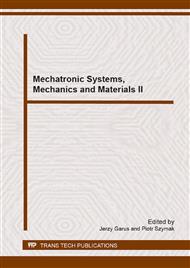p.265
p.273
p.280
p.287
p.294
p.301
p.309
p.320
p.326
Remote Control System for Rescue Robot
Abstract:
Unmanned ground platforms are increasingly used to perform tasks under direct threat to the operators life and health. Separating an operator from a controlled machine places high demands to its steering system. The requirement of reliability put to such platforms in terms of potential threats makes their steering systems being very precise controlled and tested at the stage of construction. The key element in the steering process of unmanned ground platforms are surroundings display systems which determine the success of conducting rescue operations. This paper presents an unmanned ground platform controlled by remote operator and describes some of the functionality tests of the remote control system. Keywords: Robot, Remote Control, Vision System, Teleoperation
Info:
Periodical:
Pages:
294-300
Citation:
Online since:
October 2013
Authors:
Price:
Сopyright:
© 2014 Trans Tech Publications Ltd. All Rights Reserved
Share:
Citation:


